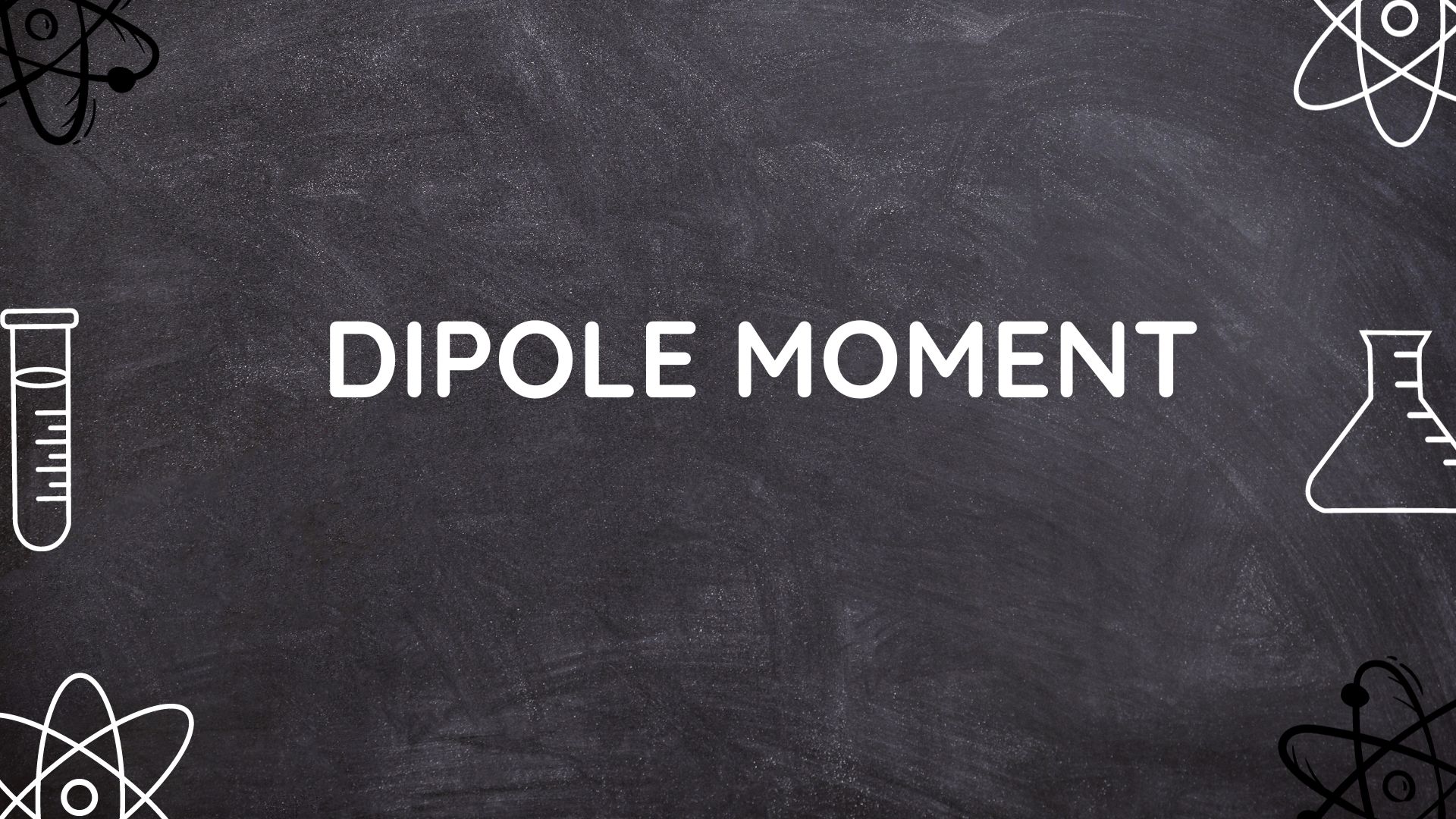Introduction
The dipole moment is a measure of the separation of positive and negative electric charges within a molecule. It is a vector quantity, meaning it has both magnitude and direction. The dipole moment arises when there is an unequal distribution of electrons in a molecule, leading to a partial positive charge at one end of the molecule and a partial negative charge at the other end. This charge separation results in a dipole, and the magnitude of the dipole moment indicates the strength of this separation. Dipole moments are important in chemistry and physics as they influence the behaviour of molecules in various contexts, including their interaction with electric fields, solvents, and other molecules.

Why is it called a Dipole Moment ?
The term “dipole moment” is derived from its components:
- Dipole: In physics and chemistry, a “dipole” refers to a pair of electric charges or poles, one positive and one negative, separated by a distance. These opposite charges create an electric dipole, which has both a magnitude and a direction. The term “dipole” comes from the Greek words “di” (two) and “polos” (axis or pole), emphasizing the presence of two poles with different electric charges.
- Moment: In this context, “moment” does not refer to a brief period of time but rather to a mathematical concept. A “moment” in physics and mathematics is a measure of a quantity’s distribution or how it is spread out. The term “moment” is used to describe the idea that the dipole characterizes the distribution of electric charge within a molecule.
So, a “dipole moment” essentially means the measure of the distribution of electric charge in a molecule where there are two opposite poles, one positive and one negative, separated by a certain distance. This name accurately reflects the fundamental concept that underlies the dipole moment’s meaning and application in the study of molecules and their electric properties.
How to calculate the Dipole Moment?
The formula for the dipole moment (μ) of a molecule when the charge separation (q) is at an angle (θ) with respect to the bond axis is given by:
μ = q .r.cos(θ)
- μ represents the dipole moment in Debye units (D)
- q is the magnitude of the charge separation (in coulombs, C).
- r is the distance between the charges (in meters, m).
- θ is the angle between the charge separation and the bond axis.
This formula takes into account the orientation of the charge separation, and the cosine of the angle θ provides the component of the dipole moment along the bond axis. The dipole moment is a vector quantity, so its magnitude and direction are influenced by both the charge separation and the angle between the charge separation and the bond axis.
Dipole moments are quantified in the standard SI units of coulomb-meters (C·m). However, due to the typically minuscule magnitude of the charges involved, the traditional unit for expressing dipole moments is the Debye. One Debye is approximately equivalent to 3.33 x 10^(-30) C·m. An average dipole moment for a molecule is approximately 1 Debye (1 D).
Relation between Dipole Moment and Polarity of Molecule
The dipole moment of a molecule is a key factor in determining whether the molecule is polar or nonpolar.
Polar Molecules
- A polar molecule has a net dipole moment, which means it has an uneven distribution of charge. This occurs when there is an electronegativity difference between the atoms within the molecule.
- The greater the electronegativity difference between atoms, the larger the dipole moment and the more polar the molecule.
- Polar molecules often have an asymmetric shape, which leads to an uneven charge distribution.
- Examples of polar molecules include water (H2O) and ammonia (NH3), which have a significant dipole moment due to the electronegativity differences between the atoms.
Nonpolar Molecules
- A nonpolar molecule has no net dipole moment, meaning there is an even distribution of charge, or the polar bonds within the molecule cancel each other out.
- Nonpolar molecules typically consist of atoms with similar or identical electronegativities.
- Nonpolar molecules often have a symmetric shape that results in a balanced charge distribution, even if there are polar bonds within the molecule.
- Examples of nonpolar molecules include diatomic gases like oxygen (O2) and nitrogen (N2), as well as hydrocarbons like methane (CH4).
Why Polar liquids have a tendency to rise against gravity in a small-diameter tube?
Intermolecular forces also give rise to a phenomenon known as capillary action, wherein a polar liquid has the propensity to move upward against gravity when placed in a narrow tube called a capillary. When a glass capillary is immersed in liquid water, the water ascends into the capillary.
Capillary action results from the interplay of two opposing force categories:
- Cohesive forces are the intermolecular forces responsible for keeping a liquid unified.
- Adhesive forces are the attractive interactions between a liquid and the material comprising the capillary.
Because polar molecules exhibit stronger intermolecular forces, i.e., cohesive forces, polar liquids tend to move upward against gravity in small-diameter tubes.
Why Polar compounds tend to have higher surface tension than nonpolar compounds?
Polar molecules have a higher surface tension because they have higher intermolecular forces of attraction due to electrostatic interaction between the partially positive atom and the partially negative atom of a neighbouring molecule. Also, the greater the polarity greater the intermolecular forces of attraction.
Uses of Dipole Moment
- Chemistry – Molecular Polarity: Identifying polarity influences chemical reactions and interactions.
- Physical Chemistry – Intermolecular Forces: Understanding forces in phase behaviour and properties.
- Materials Engineering – Surface Chemistry: Wetting and adhesion in coatings and adhesives.
- Environmental Science – Atmospheric Chemistry: Role in climate and pollutants.
- Electrochemistry – Capacitors: Dielectric properties in electronic component design.
- Electronics – Dielectric Heating: Dipole moments in microwave oven processes.
- Fluid Dynamics – Surface Tension: Influences capillary action and liquid behaviour.
For More such articles: https://kmore.info/
